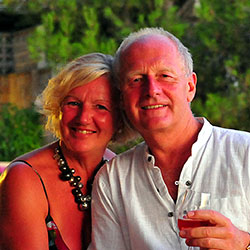If, like us, you quickly tire of simply lazing, roasting on a beach for the complete duration of your holiday, then fishing and familiarising yourself with the local people can provide a welcome distraction in Zanzibar.
Once you’ve visited Stone Town (which we’ll cover in a later review) then Zanzibar is largely an exotic beach resort with miles of white sand coral shoreline for the majority of visitors.
Not that there’s anything wrong with this and many are grateful for the opportunity to escape busy lives and hectic schedules for the opportunity simply to chill out in idyllic boutique and barefoot luxury.
Whatever our lives have thrown at us, however, we still get itchy feet after a couple of days of lazing around and seek to explore our surroundings.

Zanzibar has a limited number of distractions despite its colourful trading history as a significant port on the ancient Spice Route.
Rather than simply succumb to idleness and join one of the tours offered by our hotels, we did a bit of digging around with local guides and eventually found one who was prepared to take us to his home village on an adjacent island, via a fishing town where we could spend a few hours out with the local fishing boats.

Lush vegetation and a quieter pace to life in the rural northwest of Zanzibar
As we love being on the water and particularly exploring areas less populated by tourists, we quickly agreed to this plan. This is not born out of any dislike of our fellow humans, more out of an underlying desire to see as much of our planet that remains unspoiled with least impact by tourism – which has an unfortunate way of subsequently skewing both local economy and behaviour. Our own presence is undoubtedly the thin end of the wedge but we’d rather that than be part of the inevitable thick end!

An overloaded ‘Dala-dala’ rushes through rural Zanzibar
Early one morning, therefore, we’re picked up in battered old car by our guide and head off from Bwejuu Beach, where we’re staying, towards the northwest of the island.
The first thing that we notice is the changing geography, between the east and west coasts, surprising within the small main island of Unguja. The island is about 85 kilometres (53 ml) long and 39 kilometres (24 ml) wide. The west coast of Unguja is at once more tropical and lush, protected as it is from the Indian Ocean weather that creates the drier but perhaps more idyllic coastline to the east.

Bullock carts and earth roads are very much the norm outside of the main routes
As a by-product of its popularity, the east is more populated and developed, whereas the northwest is rural and rudimentary. Little villages dot the landscape with palm covered rooves and earth streets that are rutted by bullock carts and the ubiquitous overloaded, privately owned ‘Dala dala’, communal minibus/trucks that negotiate the roads all over the island at break-neck speeds.
After a couple of hours from our hotel (road conditions rather than distance dictating time), we arrive at Mkokotoni, a sprawling and unattractive string of concrete shops and houses along the roadside beside the coast.

Fishermen await the incoming tide in Mkokotoni
We climb out of our guide’s car and provide a novelty to the locals, unused as they are to foreigners wandering their streets. We make our way to the shore , having now met a fisherman who joins us and leads us to his boat across a wide expanse of sand and mud towards the distant sea at low tide.
Fishing boats of all sizes lay on their sides awaiting the incoming tide and provide an insight into the various methods of fishing employed by the locals.
At its most basic a crowd of fishermen will simply walk out, either with a large net or individual snorkel and mask, into the shallow waters around the coast. Here they’ll either gather fish in a large circle that closes gradually, or dip underwater to find and retrieve their wicker baskets in the hope of finding fish within.

Small community groups share boats of varying sizes and capacities to explore deeper waters, with the same techniques. It surprises us that, even when a half-mile offshore, the divers are still able to pinpoint their baskets in the absence of any markers on the surface, simply by taking visual transits from the shore.
We’re fascinated by the catch of multi-coloured starfish in their baskets, which are simply an inconvenience to the fishermen who seek more edible fayre.
Larger boats pass us, full with up to fifty fishermen, intent on similar pursuits but our little team seems content with a catch numbering about twenty fish for the morning’s haul.
We’re dropped off from our boat onto Tumbatu Island, to the northwest of Unguja, where our guide’s home village rests. The shoreline is intriguing, as a row of wooden boats is under construction – an export of Zanzibar – despite the more common fibreglass influx.

Unrefined and unchanged traditional skills employed in fishing boat building
To see these boats being made by hand, using tools that are positively medieval, illustrates how pockets of the world still retain techniques that are timeless – relying on craftsmanship rather than machinery. We could just as easily be peering into past centuries as we stand transfixed by the industry here.
We walk into Jongowe, the little village on the south coast of Tumbatu and are immediately struck by the contrast between concrete and culture here. The lifestyle of the villagers has changed little from the subsistence cultivation of crops and basic existence; now housed, however, within featureless concrete boxes as homes.

Inside they offer little comfort of furnishing or other features; their Spartan presentation testament to the lack of income.
It’s too easy for us to mourn the aesthetic loss of quaint mud huts with palm rooves but we don’t have to live in them – but whilst the substitutes here might offer a more watertight option, in terms of charm, warmth and comfort they seem of little improvement.
The spirit of the people seems little diminished however and community initiatives for education are well underway to help children find a more rewarding future for themselves. We spend a while in the school chatting to the children – mainly about Premier League football, about which our knowledge is strictly limited!

As we settle back onto our sun lounger on the white sand coral beach of Bwejuu and order a cool gin and tonic sundowner from our ‘butler’, our day out with fishermen and villagers puts our privilege into perspective. Whilst we wouldn’t want to trade places under any circumstances, it does bring a sharp reminder that our trite approach in tiring with leisure and relaxation on a sun-kissed beach, is an elusive luxury so far beyond so many.

A local ‘fisherman’ searches for octopus in the shallows of Bwejuu beach shoreline
We’re once again reminded of how fortunate we are to enjoy these wonderful windows on the world, with the option to return to our ‘busy’ lives.

If you’d like to look at our earlier review of luxury accommodation on Zanzibar, simply click here.
If you’d like to talk about your own plans or for us to arrange your own tailor-made travel throughout Africa, simply click below.

 Let us plan your inspiring journey to Zanzibar and East Africa
Let us plan your inspiring journey to Zanzibar and East Africa
Why not download the TLC World guide brochure or give us a call today on 01202 030443, or simply click ‘enquire’ to submit your own personal itinerary request




































